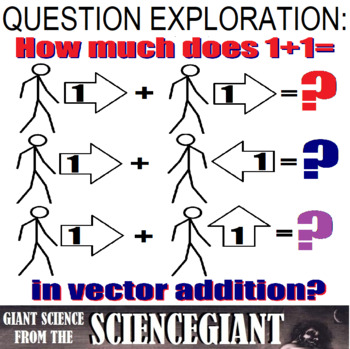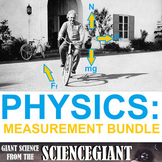Question Exploration: How Much Does 1+1= In Vector Addition? PART 1
- Word Document File
Also included in
- Teachers use the Strategic Instruction Model (SIM) Framing Routine to transform abstract main ideas and key topics into a concrete representation that helps students think about and talk about the key topic and essential related information. SIM is about promoting effective teaching and learning ofPrice $7.85Original Price $11.64Save $3.79
Description
How much does 1+1 equal? 2? 0? 1.414? It depends on how you do vector addition in physics! This question exploration explains definitions, how to distinguish between vectors and scalars, and gives Ss practice adding vectors in one dimension and in two dimensions.
Question Exploration Routines are instructional methods that teachers can use to help a diverse student population understand a body of content information by carefully answering a critical question to arrive at a main idea answer. Students taught using the content enhancement routines earned higher total test scores than did students taught using the lecture-discussion method.
Personally, I use the Concept Enhancement routines to figure out what I want to say and how I want to say it. I keeps my "Sage on the Stage" time limited to what fits onto 2-3 page for the Question Exploration. This product includes the completed routines, and the student guide blanked except for vocabulary, scaffolding questions, and graphics already filled in.
These Concept Enhancement Routines have the following learning objectives and outcomes: Students Will Be Able To (SWBAT)
- SWBAT distinguish between vectors and scalars, practice adding vectors in one dimension and in two dimensions; adding several vectors.
- SWBAT graphically and mathematically find the sum of multiple vectors in 1 dimension.
- SWBAT use the computer simulation to practice adding vectors using head-to-tail, parallelogram and component methods.
These Concept Enhancement Routines are classroom tested to help students with the following Florida Next Generation Sunshine State Standards in Science:
- SC.912.P.12.1 Distinguish between scalar and vector quantities and assess which should be used to describe an event.
- SC.912.P.12.2 Analyze the motion of an object in terms of its position, velocity, and acceleration (with respect to a frame of reference) as functions of time.
Related Products
• Question Exploration: How Much Does 1+1= In Vector Addition? PART 1
• Question Exploration: How Much Does 1+1= In Vector Addition? PART 2
• Question Exploration: How to Use Vector Components to Analyze Projectile Motion
• Concept Compare: Trigonometry Review (Sine, Cosine, Tangent)
#StayGiant and stay up on my new resources and STEM news. Look for the green ★ star near the top of any page within my store and click "FOLLOW". Or follow @TheScienceGiant Twitter. Stand on The Shoulders of Giants, and together we'll see further, inspire students, and enlighten inquisitive minds!






